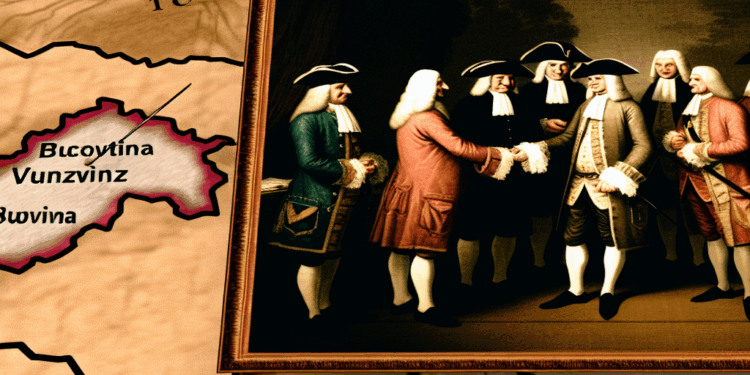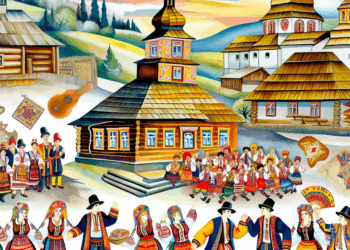Little-known historical facts of Bukovyna
Bukovyna, a region in the northwest of the Chernivtsi region of Ukraine, is a unique place with a rich history that spans many cultures and eras. This article aims to reveal little-known but significant historical facts about Bukovyna with a focus on the princely times, the Austrian Empire, the interwar years and the Soviet era.
Princely times
The first mention of Bukovina as a separate territory dates back to the 13th century, when it was part of the principality of Galicia-Volhynia. In 1340, after the death of Prince Yuri II, the territories of the future Bukovina were transferred to the Lithuanian Principality. In this context, the next important event was the annexation of the lands to the Moldavian Principality in the first half of the XV century. One of the little-known facts is that it was in Bukovina that the first school in Moldavia was founded in 1482, opened by the Metropolitan of Moldavia, which stemmed from the need for education of the clergy and the general public.
It is also worth mentioning that in the XV-XVI centuries Bukovina became an important trading hub on the way from Venice to Kiev. Few people know that at that time a network of fairs and markets developed here, where not only local goods were sold, but also exotic goods from distant countries. These fairs were organised on the model of those that existed in European countries and attracted merchants from various parts of Europe.
Times of the Austrian Empire
In 1775 Bukovina became a part of the Austrian Empire, which led to significant changes in the socio-economic and cultural life of the region. A little-known fact is that under Austrian rule, active construction of infrastructure, including roads and railways, began. This contributed to economic recovery and increased trade links with other regions.
At this time, the population of Bukovina was increasing and the ethnic composition became more and more diverse. For example, at the end of the 19th century, about 30 per cent of the region’s Jewish population was concentrated in Chernivtsi, the capital of Bukovina, which had a significant impact on social and cultural life. Bukovina became one of the centres of Jewish culture, and Hebrew and Yiddish literature began to develop here.
It is necessary to mention the role of Bukovina in the Austrian educational system. In 1875, the University of Chernovtsy was founded, which was one of the first universities in Austria to offer multilingual education. The university quickly gained the status of a cultural and scientific centre and attracted students from all over the region. An interesting fact is that it was here that the famous Austrian philosopher and sociologist Sigmund Freud, who greatly influenced the development of psychoanalysis, taught.
Interwar years
After World War I, Bukovina became part of the Kingdom of Romania, which also brought changes to the life of the region. Between the world wars, processes of national self-determination took place in Bukovina. In 1925, a new Constitution was adopted, which returned more rights to ethnic minorities, but in practice they faced difficulties in their endeavour to represent and participate in the political process.
A little-known fact is the establishment of the Bukovina Cultural Centre in Chernivtsi in 1926, which became an important meeting place for representatives of various ethnic groups. It hosted lectures, exhibitions and theatre performances, which promoted cultural integration and mutual understanding between peoples.
Economic and social changes are also worth mentioning. During this period, agriculture was developing and new technologies, such as mechanisation and the use of chemical fertilisers, began to be introduced. Bukovyna peasants started to use more productive farming methods, which contributed to the improvement of the living standards of the population.
Soviet era
In 1940, after the Soviet Union took over Bukovina, the region became part of the Ukrainian SSR. The period of Soviet rule had a significant impact on the social structure and cultural development of the region. A little-known aspect of this era is the process of mass collectivisation, which was accompanied by considerable resistance on the part of the peasants, resulting in various forms of protest and revolts, often brutally suppressed by the authorities.
The Soviet era was also a time of significant changes in education and culture. Schools began to introduce new curricula aimed at promoting Soviet ideals. However, some attention was also paid to local traditions at this time, and in 1955 a group of researchers was established to study the historical and cultural heritage of Bukovina.
An interesting fact is that in the 1960s a new movement towards the revival of cultural identity began in Bukovina. Various cultural and youth initiatives were particularly active, which aimed at preserving linguistic and cultural traditions.
Conclusion
The history of Bukovina is a mosaic of diverse cultural, social and historical processes that have changed the region over the centuries. Little-known but significant facts that have been discussed in this article help to better understand the uniqueness and complexity of Bukovina’s history. This region, located at the crossroads of different civilisations, witnessed many changes that not only shaped its identity, but also left a trace in the historical memory of the peoples.
Thus, the study of Bukovina’s history not only helps to restore the lost threads of cultural dialogue, but also enriches our understanding of the historical processes that took place in Eastern Europe. It is important to remember the significance of each period and each event that shaped this unique place.








